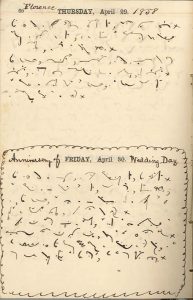 While working in Salt Lake City in 2011, I met a sort of expert in lost arts named LaJean Carruth. Besides being a weaver, she also taught a small class on nineteenth-century Pitman Shorthand,[1] which she invited me to join. Being a lover of lost arts myself, I naturally agreed.
While working in Salt Lake City in 2011, I met a sort of expert in lost arts named LaJean Carruth. Besides being a weaver, she also taught a small class on nineteenth-century Pitman Shorthand,[1] which she invited me to join. Being a lover of lost arts myself, I naturally agreed.
For those unfamiliar with Pitman Shorthand, Sir Isaac Pitman’s creation of a phonetic shorthand system in 1837 marked the beginning of one of the most lasting forms of shorthand, in use for well over a hundred years, particularly in Great Britain. With a variety of strokes to indicate consonants and interspersed dots and short dashes representing vowels, it was primarily used for its speed and ability to conserve space.[2] As a result, many records from the mid-1800s are written in Pitman Shorthand. Continue reading Secrets in shorthand